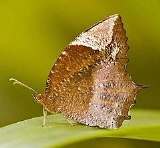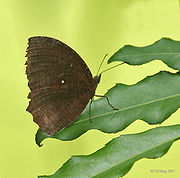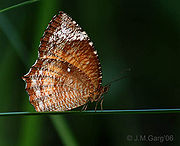
Elymnias hypermnestra
Encyclopedia
The Common Palmfly, Elymnias hypermnestra, is a species of satyrid
butterfly found in south Asia
.
This butterfly species is dimorphic
, males and females do not look alike. Males exhibit black colored upperside forewings with small blue patches and reddish brown color on upperside hindwings, while the females mimic
butterfly species of the genus Danaus
.
Race caudata (Western Ghats
) Males and female resembles E. undularis, Drury, but both sexes have the wings longer, proportionately to their breadth, and the tail at apex of vein 4 on the hind wing longer. Upperside: male differs from E. undularis as follows :—
the subterminal and preapical spots on the fore wing white suffused slightly with dark scales; the terminal half of the hind wing tawny, more or less suffused with dusky black, which in some specimens forms a distinct border along the termen. Female similar to the female of E. undularis, but the black more extended ; veins 2, 3, and 4 on the hind wing broadly bordered with black. Underside: Female differs from E. undularis in the more conspicuous broadly triangular white pre-apical patch on the fore wing, and in the prominence of the broad tawny terminal half of the upperside of the hind wing, which shows through a pale, sometimes pinkish-brown on the underside. Antennae, head, thorax and abdomen brown, paler beneath and much paler in the female than in the male.
_female_i_img_0493.jpg)


 Race undularis (Subhimalayas and Southeast Asia) Male upperside blackish brown. fore wing with a subterminal series of blue or sometimes slightly green elongate spots, curving strongly inwards and getting more elongate opposite apex, forming almost an oblique bar up to the costa. Hind wing: the terminal margin broadly bright chestnut, sometimes with a subterminal paler spot in two or more of the interspaces. Underside pale brown, the basal two-thirds of both fore and hind wing densely, the outer third more sparsely covered with dark ferruginous, somewhat broad, transverse striae. Fore wing with a broadly triangular pale purplish-white preapical mark; both fore and hind wings with a broad subterminal area purplish white. Hind wing with a small white spot opposite middle of the costa and a more or less complete series of more obscure whitish subterminal spots. Antennae, head, thorax and abdomen brown; abdomen beneath paler.
Race undularis (Subhimalayas and Southeast Asia) Male upperside blackish brown. fore wing with a subterminal series of blue or sometimes slightly green elongate spots, curving strongly inwards and getting more elongate opposite apex, forming almost an oblique bar up to the costa. Hind wing: the terminal margin broadly bright chestnut, sometimes with a subterminal paler spot in two or more of the interspaces. Underside pale brown, the basal two-thirds of both fore and hind wing densely, the outer third more sparsely covered with dark ferruginous, somewhat broad, transverse striae. Fore wing with a broadly triangular pale purplish-white preapical mark; both fore and hind wings with a broad subterminal area purplish white. Hind wing with a small white spot opposite middle of the costa and a more or less complete series of more obscure whitish subterminal spots. Antennae, head, thorax and abdomen brown; abdomen beneath paler.
Female Upperside tawny, veins black. Fore wing : the dorsal margin broadly black; the apical area beyond a line curving from the tornus, round apex of the cell and a little beyond it, to the base of the costa also black, the wing crossed preapically by a conspicuous, broad, oblique white bar, and three subterminal white spots. Hind wing: dorsal margin dusky; terminal broadly, costal margin more narrowly black ; a subterminal series of four white spots. Underside tawny, with markings similar to those in the male; the pale whitish markings more extensive ; the dorsal margin broadly without striae.
Race fraterna, Butler (Sri Lanka) is an insular representative of E. undularis. The male differs on the upperside in the more or less complete absence of the subterminal and preapical blue markings on the fore wing; and in the broad terminal border of the hind wing being of a much brighter, almost ochraceous chestnut. On the underside the pale markings are somewhat restricted. The male very closely resembles, both on the upper and under side, the male of E. undularis.
, Calamus thwaitesii, Phoenix lourerii and Licuala chinensis.
Race undularis "Elongate, fusiform, setose; green with longitudinal dorsal and lateral yellow lines, and a subdorsal row of yellow elongated spots, which are centred with red and posteriorly edged with blue; head brownish, armed with two erect brownish setose processes; anal segment also with two red slender hindward-projecting processes."
Larvae are known to be cannibalistic.
Satyrinae
Satyrinae, the satyrines or satyrids, commonly known as the Browns, is a subfamily of the Nymphalidae . They were formerly considered a distinct family, Satyridae. This group contains nearly half of the known diversity of brush-footed butterflies...
butterfly found in south Asia
Asia
Asia is the world's largest and most populous continent, located primarily in the eastern and northern hemispheres. It covers 8.7% of the Earth's total surface area and with approximately 3.879 billion people, it hosts 60% of the world's current human population...
.
Description
As some other species in the genus Elymnias, the Common Palmfly presents a precostal cell on the hindwings and a hair tuft of androconial scales on dorsal discal cell of hindwings.This butterfly species is dimorphic
Sexual dimorphism
Sexual dimorphism is a phenotypic difference between males and females of the same species. Examples of such differences include differences in morphology, ornamentation, and behavior.-Examples:-Ornamentation / coloration:...
, males and females do not look alike. Males exhibit black colored upperside forewings with small blue patches and reddish brown color on upperside hindwings, while the females mimic
Mimic
In evolutionary biology, mimicry is the similarity of one species to another which protects one or both. This similarity can be in appearance, behaviour, sound, scent and even location, with the mimics found in similar places to their models....
butterfly species of the genus Danaus
Monarch butterfly
The Monarch butterfly is a milkweed butterfly , in the family Nymphalidae. It is perhaps the best known of all North American butterflies. Since the 19th century, it has been found in New Zealand, and in Australia since 1871 where it is called the Wanderer...
.
Race caudata (Western Ghats
Western Ghats
The Western Ghats, Western Ghauts or the Sahyādri is a mountain range along the western side of India. It runs north to south along the western edge of the Deccan Plateau, and separates the plateau from a narrow coastal plain along the Arabian Sea. The Western Ghats block rainfall to the Deccan...
) Males and female resembles E. undularis, Drury, but both sexes have the wings longer, proportionately to their breadth, and the tail at apex of vein 4 on the hind wing longer. Upperside: male differs from E. undularis as follows :—
the subterminal and preapical spots on the fore wing white suffused slightly with dark scales; the terminal half of the hind wing tawny, more or less suffused with dusky black, which in some specimens forms a distinct border along the termen. Female similar to the female of E. undularis, but the black more extended ; veins 2, 3, and 4 on the hind wing broadly bordered with black. Underside: Female differs from E. undularis in the more conspicuous broadly triangular white pre-apical patch on the fore wing, and in the prominence of the broad tawny terminal half of the upperside of the hind wing, which shows through a pale, sometimes pinkish-brown on the underside. Antennae, head, thorax and abdomen brown, paler beneath and much paler in the female than in the male.
_female_i_img_0493.jpg)



Female Upperside tawny, veins black. Fore wing : the dorsal margin broadly black; the apical area beyond a line curving from the tornus, round apex of the cell and a little beyond it, to the base of the costa also black, the wing crossed preapically by a conspicuous, broad, oblique white bar, and three subterminal white spots. Hind wing: dorsal margin dusky; terminal broadly, costal margin more narrowly black ; a subterminal series of four white spots. Underside tawny, with markings similar to those in the male; the pale whitish markings more extensive ; the dorsal margin broadly without striae.
Race fraterna, Butler (Sri Lanka) is an insular representative of E. undularis. The male differs on the upperside in the more or less complete absence of the subterminal and preapical blue markings on the fore wing; and in the broad terminal border of the hind wing being of a much brighter, almost ochraceous chestnut. On the underside the pale markings are somewhat restricted. The male very closely resembles, both on the upper and under side, the male of E. undularis.
Food plants
Cocos nucifera, coconut. Calamus pseudo-tenuis, Calamus rotangCalamus rotang
Calamus rotang L., rotang or Rattan Palm is one of the scandent palms used for Malacca cane and rattan in the making of furniture, baskets, walking-sticks, umbrellas, tables and general wickerwork, and is found in Southwest Asia...
, Calamus thwaitesii, Phoenix lourerii and Licuala chinensis.
Larva
Race caudata "Spindle-shaped, slender, transversely rugose and clothed with short stout bristles......; head large, surmounted by two stout horns, sloping backwards, slightly branched at the ends ; a pair of long straight caudal spines setose like the body; colour bright green with longitudinal yellow lines more or less distinct and two rows of large yellow spots tinged with green and sometimes tipped with black on the back; head dark brown, with a yellow cheek-stripe and frontal-line."Race undularis "Elongate, fusiform, setose; green with longitudinal dorsal and lateral yellow lines, and a subdorsal row of yellow elongated spots, which are centred with red and posteriorly edged with blue; head brownish, armed with two erect brownish setose processes; anal segment also with two red slender hindward-projecting processes."
Larvae are known to be cannibalistic.

